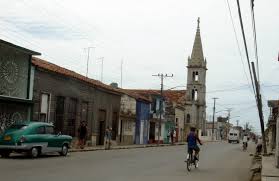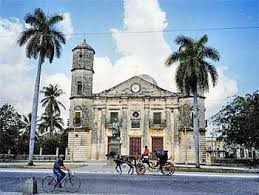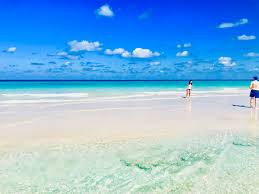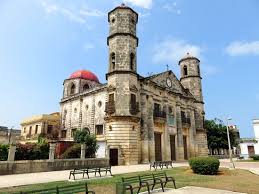

 CARDENAS, CUBA, CIUDAD LLAMADA “EL CHARLESTON DEL CARIBE”. CARDENENSES. FOTOS.
CARDENAS, CUBA, CIUDAD LLAMADA “EL CHARLESTON DEL CARIBE”. CARDENENSES. FOTOS.
Cárdenas es un municipio y ciudad en la provincia de Matanzas de Cuba, a unos 116 km (72 millas) por aire [156 km (97 millas) por carretera] al este de La Habana. Cárdenas es la decimoquinta ciudad cubana más poblada y la segunda más poblada por no ser cabecera provincial, después de Manzanillo.
La bandera cubana se izó por primera vez sobre Cuba en esta histórica ciudad de calles rectas y estrechas (el “Charleston del Caribe”), carruajes tirados por caballos, industria y “cangrejos” (cangrejos azules). Fue en Cárdenas donde José Arechabala S.A. lanzó e inició la producción de Havana Club en 1934.
Geografía
Cárdenas es una ciudad portuaria marítima sobre el nivel y la orilla algo pantanosa de una espaciosa bahía de la costa norte de la isla (Bahía de Cárdenas), resguardada por un largo promontorio (península de Hicacos, incluido el balneario de Varadero). La ciudad se encuentra entre el mar y las colinas.
Se ha extraído una gran cantidad de asfalto del lecho del puerto. Un flujo de agua dulce del lecho del puerto es otra característica peculiar; presumiblemente proviene de las desembocaduras de los ríos subterráneos.
En su mayoría hay calles estrechas, varias plazas (incluida la Plaza de Colón, con una estatua de bronce de Colón entregada a la ciudad por la reina Isabel II y erigida en 1862) y edificios comerciales y públicos importantes y elegantes, incluida la ornamentada iglesia parroquial diseñada por el arquitecto Rafael Carrerá, quien también construyó el famoso Palacio Aldama en Centro Habana.
Subdivisión
Antes de la reforma de 1976, Cárdenas se dividió en los barrios de Cantel, Fundición, Guásimas, Marina, Méndez Capote, Pueblo Nuevo y Versalles.
La mundialmente famosa playa y ciudad turística de Varadero es parte del municipio. Otros pueblos incluidos en el territorio son Boca de Camarioca, Buena Vista, Camarioca, Cantel, Central José Smith Comas, Dos de Diciembre, El Castillito, Guásimas, Humberto Álvarez, Julián Alemán, La Emilia, Los Morúa, Méndez Capote, Merceditas, Precioso , San Joaquín de Mora, Santa Marta y Siguapa.
Historia
Cárdenas fue fundada en 1828, con la ayuda de varias antiguas familias aristocráticas hispano-cubanas de la cercana capital provincial de Matanzas y en 1861 ya contaba con 12,910 habitantes. La finalización del ferrocarril en 1841 condujo a un mayor desarrollo. Cárdenas fue una de las primeras ciudades de Cuba en contar con servicio eléctrico, transporte público (tranvías), telégrafo y teléfono.
La ciudad no se diseñó según la costumbre española tradicional de la plaza central, sino que se inspiró en un patrón de cuadrícula perpendicular de América del Norte, inspirado en la ciudad de Charleston, Carolina del Sur, con la ayuda de ingenieros paisajistas estadounidenses (confederados). Otro vínculo notable entre la ciudad y Carolina del Sur fue el nativo de Cárdenas, Ambrosio José Gonzales, quien pasaría varios años residiendo allí y se casó con Harriet Elliot, hija del destacado plantador de Carolina del Sur y senador estatal William Elliot, en 1856, viviendo a 24 millas de Charleston. . Según el historiador Antonio Rafael de la Cova, Gonzales se uniría a las fuerzas confederadas y fue nominado para el rango de general seis veces, pero no tuvo éxito debido a una disputa personal con Jefferson Davis.
En 1850, el general venezolano Narciso López, junto con algunos estadounidenses y exiliados cubanos (entre ellos Gonzales), aterrizó aquí en una expedición filibustera, y retuvo el pueblo por unas horas, abandonándolo al ver que la gente no se levantaría para apoyar. él en sus esfuerzos por asegurar la independencia cubana. López, sin embargo, izó por primera vez la moderna Bandera de Cuba, diseñada por él junto con un cubano local Miguel Teurbe Tolon.
En mayo de 1898, durante la Guerra Hispanoamericana, se libraron tres batallas notables en Cárdenas. Sin embargo, el crédito por las victorias españolas va principalmente a las fuerzas cubanas locales, lideradas, entre otros, por el general Carlos M. de Rojas.
A finales del siglo XIX y principios del XX, Cárdenas era una de las principales ciudades exportadoras de azúcar de Cuba y había recibido una gran afluencia de inmigrantes europeos, incluso de Irlanda, Francia, Italia y Córcega; muchas familias de Cárdenas eran conocidas por con apellidos que suenan extranjeros, como Jones, Larrieu, Smith, Villa-Giorgi y Sterling, entre otros.
En 1907 la población era de 24.280 habitantes. La poca profundidad del puerto requería que las cargas se aligeraran y se cargaran repetidamente. Después de que el huracán Cuba-Brownsville de 1933 azotara gravemente la ciudad, José Arechabala S.A. financió el dragado del puerto y la reforma de todo el litoral, incluida la construcción del Monumento a la Bandera. Esto justificó el nombramiento de Arechabala como Benefactor eminente de Cárdenas. La región circundante se cultiva por su fertilidad.
Demografía
En 2007, el municipio de Cárdenas tenía una población de 103.087. Con una superficie total de 566 km2 (219 millas cuadradas), tiene una densidad de población de 182,1 / km2 (472 millas cuadradas). Cárdenas experimenta un crecimiento poblacional del 0.24% anual.
Gente notable
José Arechabala (1847-1923), industrial; Emilio Bobadilla (1862-1921), escritor; Enriqueta García Martín, socialité, terrateniente y barón del azúcar; Belisario López (1913-1969), flautista y director de orquesta; Arturo Núñez (1913-1981), pianista y director de orquesta; Paquito Hechavarría (1939–2012), pianista; Ernest Sosa (nacido en 1940), filósofo; Juan Pablo Villar Alemán (nacido en 1949), artista visual; Danell Leyva Gimnasta Cubano-Americana, medallista de bronce olímpico All-Around 2012; José Méndez (1887-1928), lanzador y gerente de béisbol del Salón de la Fama de la Liga Negra; Elián González (nacido en 1993), un niño en el centro de una controversia política entre Cuba y Estados Unidos en 2000.
 CARDENAS, CUBA, CITY CALLED “THE CHARLESTON OF THE CARIBBEAN”. CARDENENSES. PHOTOS.
CARDENAS, CUBA, CITY CALLED “THE CHARLESTON OF THE CARIBBEAN”. CARDENENSES. PHOTOS.
Cárdenas (Spanish pronunciation: [ˈkaɾðenas]), Cárdenas is a municipality and city in the Matanzas Province of Cuba, about 116 km (72 mi) by air [156 km (97 mi) by road] east of Havana. Cárdenas is the 15th most-populated Cuban city and the second most populated one not being a provincial seat, after Manzanillo.
The Cuban flag was first raised over Cuba in this historic city of straight and narrow streets (the “Charleston of the Caribbean”), horse-drawn carriages, industry, and “cangrejos” (blue crabs). It was in Cárdenas where José Arechabala S.A. launched and started production of Havana Club in 1934.
Geography
Cárdenas is a maritime port town on the level and the somewhat marshy shore of a spacious bay of the northern coast of the island (Bay of Cárdenas), sheltered by a long promontory (Hicacos peninsula, including the Varadero beach resort). The city lies between the sea and hills.
A large quantity of asphalt has been taken from the bed of the harbor. A flow of fresh water from the bed of the harbor is another peculiar feature; it presumably comes from the outlets of subterranean rivers.
There are mostly narrow streets, various squares (including the Plaza de Colón, with a bronze statue of Columbus given to the city by Queen Isabella II. and erected in 1862) and substantial and elegant business and public buildings, including the ornate parish church designed by Architect Rafael Carrerá, who also built the famous Palacio Aldama in Central Havana.
Subdivision
Before the 1976 reform, Cárdenas was divided into the barrios of Cantel, Fundición, Guásimas, Marina, Méndez Capote, Pueblo Nuevo and Versalles.
The world-famous beach and resort town of Varadero is part of the municipality. Other villages included in the territory are Boca de Camarioca, Buena Vista, Camarioca, Cantel, Central José Smith Comas, Dos de Diciembre, El Castillito, Guásimas, Humberto Álvarez, Julián Alemán, La Emilia, Los Morúa, Méndez Capote, Merceditas, Precioso, San Joaquín de Mora, Santa Marta and Siguapa.
History
Cárdenas was founded in 1828, with the help of several old aristocratic Spanish-Cuban families from the nearby provincial capital of Matanzas and in 1861 already had 12,910 inhabitants. The completion of the railroad in 1841 led to further development. Cárdenas was one of the first cities in Cuba to have electric service, public transportation (trams), telegraph, and telephone.
The city was not laid out in the traditional central-plaza Spanish custom, but rather, inspired on a North American perpendicular grid pattern, modeled on the city of Charleston, South Carolina, with the help of American (Confederate) landscape engineers. Another notable link between the city and South Carolina was Cárdenas native, Ambrosio José Gonzales, who would spend several years residing there and married Harriet Elliot, daughter of prominent South Carolina planter and state Sen. William Elliot, in 1856, living 24 miles from Charleston. According to historian Antonio Rafael de la Cova, Gonzales would join the Confederate forces and was nominated for the rank of general six times but was unsuccessful due to a personal feud with Jefferson Davis.
In 1850, the Venezuelan General Narciso López, along with some Americans and Cuban exiles (including Gonzales), landed here on a filibustering expedition, and held the town for a few hours, abandoning it when he saw that the people would not rise to support him in his efforts to secure Cuban independence. López did, however, raise for the first time the modern Flag of Cuba, designed by him along with a local Cuban Miguel Teurbe Tolon.
In May 1898, during the Spanish–American War, three notable battles were fought at Cardenas. However, credit for the Spanish victories goes mainly to the local Cuban forces, led, among others, by General Carlos M. de Rojas.
In the late 19th century and early 20th Century, Cárdenas was one of the main sugar-exporting towns of Cuba, and had received a great influx of European immigrants, including from Ireland, France, Italy, and Corsica – many Cárdenas families were known for having foreign-sounding surnames, such as Jones, Larrieu, Smith, Villa-Giorgi, and Sterling, among others.
By 1907 the population was 24,280. The shallowness of the harbor required loads to be lightened and repeated loading of cargoes. After the 1933 Cuba–Brownsville hurricane hit the city badly, José Arechabala S.A. financed the dredging of the harbor and the reform of the whole coastline, including the construction of the Monumento a la Bandera (monument to the national Cuban flag). This justified the Arechabala appointment as the Benefactor eminent of Cárdenas. The surrounding region is farmed for its fertility.
Demographics
In 2007, the municipality of Cárdenas had a population of 103,087. With a total area of 566 km2 (219 sq mi), it has a population density of 182.1/km2 (472/sq mi). Cardenas experiences a population growth of 0.24% a year.
Notable people
José Arechabala (1847–1923), industrialist; Emilio Bobadilla (1862–1921), writer; Enriqueta García Martín, socialite, landowner, and sugar baron; Belisario López (1913–1969), flautist and bandleader; Arturo Núñez (1913–1981), pianist and bandleader; Paquito Hechavarría (1939–2012), pianist; Ernest Sosa (born 1940), philosopher; Juan Pablo Villar Alemán (born 1949), visual artist; Danell Leyva Cuban-American Gymnast, 2012 Olympic All-Around bronze medalist; José Méndez (1887-1928), Hall of Fame Negro League baseball pitcher and manager; Elián González (born 1993), a child at the centre of a political controversy between Cuba and the United States in 2000.
Agencies/ Wiki/ Internet Photos/ Arnoldo Varona/ www.TheCubanHistory.com
THE CUBAN HISTORY, HOLLYWOOD.















